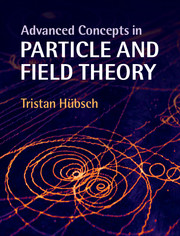Book contents
- Frontmatter
- Epigraph
- Contents
- Preface
- I Preliminaries
- II The Standard Model
- III Beyond the Standard Model
- 8 Unification: the fabric of understanding Nature
- 9 Gravity and the geometrization of physics
- 10 Supersymmetry: boson–fermion unification
- 11 Strings: unification of all foundations of reality
- IV Appendices
- A Groups: structure and notation
- B A lexicon
- C A few more details
- References
- Index
8 - Unification: the fabric of understanding Nature
from III - Beyond the Standard Model
- Frontmatter
- Epigraph
- Contents
- Preface
- I Preliminaries
- II The Standard Model
- III Beyond the Standard Model
- 8 Unification: the fabric of understanding Nature
- 9 Gravity and the geometrization of physics
- 10 Supersymmetry: boson–fermion unification
- 11 Strings: unification of all foundations of reality
- IV Appendices
- A Groups: structure and notation
- B A lexicon
- C A few more details
- References
- Index
Summary
Just as done several times in the previous chapters, we reconsider the historical development of the key aspects of modern physics, using the benefit of hindsight to perceive the character of this development. Throughout the foregoing material, the Democritean atomism provided the warp, complemented by the gauge principle as its weft. Along the way, however, this fabric reveals the ubiquity of the third conceptual strand (woof, as it were [lexicon entry on p. 508, in Appendix B.1]) – unification; we now turn to explore this more closely.
8.1 Indications
The Newtonian theory of gravity unites the mechanics of the so-called terrestrial and the celestial objects and so eradicates this difference postulated within the Aristotelian philosophy of Nature, which the Roman Catholic clergy (sanctioned by the AD 313 Edict of Milan) imposed as exclusive of all other world views from the pre-hellenic and the hellenic cultures. According to Newton's law of gravity – as a descriptive model of this natural phenomenon – gravity is obeyed equally by both the Sun and the Moon, and the planets and the stars, by the communication satellites and the rockets as well as the Rockettes, by both the basketball and the baseball balls as well as the players in those games, and of course also by the apple that supposedly fell from the tree under which Newton sat…
Of course, Newton's unified description of Nature is not a unification of pre-existing theoretical models – in the contemporary sense of the word “model.” It is, however, one of the first rigorous applications of the principle that Nature is one and that it can be understood in a unified fashion, and not as a (jury rigged) patchwork of different and diverse ideas – each with but a very narrow aim and applicability.
It behooves us then to examine also the nature of our ideas about unification.
- Type
- Chapter
- Information
- Advanced Concepts in Particle and Field Theory , pp. 293 - 314Publisher: Cambridge University PressPrint publication year: 2015

